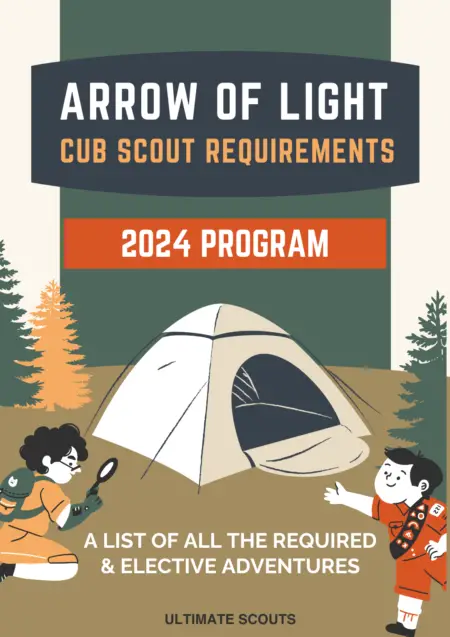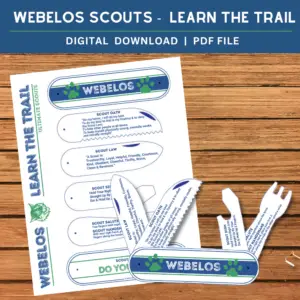What Are The Arrow of Light Requirements? (2024)
What Are The Arrow of Light Requirements? (2024)
Starting June 2024 the Arrow of Light Scouts will be asked to do 6 of the Required Adventures and 2 of the over a dozen Elective Adventures now being offered to earn their Arrow of Light Rank

Arrow of Light Cub Scout - Required Adventures
The following 6 Adventures are required for a Arrow of Light Scout to receive achieve Arrow of Light rank. You can see all the details in the Arrow of Light Scout Handbook. If you are looking for a quick way to see all of the adventures and requirements we have created a printable “cheat sheet” that gives a quick overview of all the activities that can be placed in your Scout Binder for quick reference.
- Demonstrate the patrol method by choosing a patrol name & electing a patrol leader. Discuss the benefits of using the patrol method.
- Get to know the members of your patrol.
- Recite the Scout Oath & Scout Law with your patrol
- With your patrol, create a code of conduct.
- Demonstrate the Scouts BSA sign, Scouts BSA Salute, & Scouts BSA Handshake. Show how each is used.
- Learn the Scouts BSA slogan & motto.
- With your patrol, or with your parent or legal guardian visit a scouts BSA troop.
- At home with your parent or Legal guardian do the activities in the booklet, “How to Protect Your Children from Child Abuse: a Parents Guide.”
- Learn about the Scout Basic Essentials.
- Determine what you will bring on an overnight campout including a tent, sleeping bag/gear & how you will carry your gear.
- Review the 4 points of the BSA SAFE Checklist & how you will apply them on the campout.
- Locate the camp & campsite on a map.
- With your patrol or a Scouts BSA Troop, participate in a campout.
- Upon arrival at the campout determine where to set up your campsite kitchen, eating area, tents, & firepit. Help the patrol set up the patrol gear before setting up your tent.
- Explain how to keep food safe & the kitchen area sanitary at the campsite. Demonstrate your knowledge during the campout.
- After your campout discuss with your patrol what went well & what you would do differently next time. Include how you followed the Outdoor Code & the Leave No Trace Principles for Kids.
- Plan a balanced meal that you would eat when camping. Prepare the meal using the gear you would use on a campout.
- Examine what it is to be physically fit & how you incorporate this in your life. Track the number of times you are active for 30 minutes or longer over 14 days. Share with your patrol or family what you enjoyed & if you feel you are living up to the Scout Oath of being physically fit.
- Be active for 30 minutes with your patrol, a younger den, or at least 1 other person, which includes both stretching & moving.
- Review your BSA Annual Health & Medical record with your parent or guardian. Discuss your ability to participate in patrol & pack activities.
- Identify a community service project that your patrol or pack could accomplish. Use the BSA SAFE Checklist & develop a plan to conduct the service project safely.
- Participate in a service project for a minimum of 2 hours or multiple service projects for a total of 2 hours.
- With permission from your parent or legal guardian, watch the Protect Yourself Rules video for the ARoow of Light rank.
- Explain what you should do if you encounter someone in need of first aid.
- Demonstrate what to do for hurry cases of first aid: serious bleeding, heart attack or sudden cardiac arrest, stopped breathing, stroke, poisoning.
- Demonstrate how to help a choking victim.
- Demonstrate how to treat shock.
- Demonstrate how to treat the following: cuts & scratches, burns & scalds, bites & stings or insects & animals, & nosebleeds.
- Make a personal first aid kit. Demonstrate the proper use of each item.
- Discuss with your parent or legal guardian about your family’s faith traditions or one of your choosing. Choose a view value of that faith tradition that is related to the Scout Law. Discuss with your family how each family member demonstrates this value.
- Meet with a representative of a faith-based organization in your local community that provides a service that assists people in crisis regardless of their faith. Identify who they help & how.
- Discuss with your parent, legal guardian, or adult leader what “Duty To God” means to you. Tell how you practice your Duty to God in your daily life.
Arrow of Light Cub Scout Elective Adventure
The following Adventures are elective and only 2 are required to be completed to earn the Arrow of Light rank. All of the adventures are broken down in the Arrow of Light Scout Handbook.
- Identify foods grown or processed in your state.
- Determine the benefits of purchasing food that is locally grown or processed.
- Explore the concept of a food desert.
- explore the concept of a food oasis.
- Learn how individuals can reduce food waste.
- Participate in a conservation service project
- Decide on gear & supplies you should bring for a long bike ride.
- Discover how multi-gear bicycles work and their benefit.
- Show how to lubricate a chain.
- Pick a bike lock you will use. Demonstrate the operation of locks, how to secure your bike with it, & how to carry it while riding.
- Repair a flat tire.
- With your family, patrol, or pack, use a map & plan a bicycle ride that is at least 10 miles.
- With your patrol, pack, or
- Learn the focus, related sciences, & products of civil, electrical, & mechanical engineers.
- Pick 1 of the engineering fields from requirement 1 to complete the following requirements.
- Examine a set of blueprints or specifications used by your choice of engineer.
- Identify a project that you would like to build.
- Using the engineering process, build your project.
- With an adult, use a weather app to see the forecast for your outdoor adventure & discuss any preparation needed to accommodate the weather.
- With an adult, find a knot-tying app. Select 1 knot to learn & tie it using the app.
- Discuss how technology has improved camping gear,
- Think of a way technology can improve the camping gear that you used on one of your adventures.
- Estimate food measurements.
- Estimate the time of day.
- Estimate the height of a distant object.
- Estimate the distance between 2 points.
- Make a plan to go fishing. Determine where you will go & what type of fish you plan to catch. All of the following requirements are to be completed based on your choice.
- Use the BSA SAFE checklist to plan what you need for your fishing experience.
- Describe the environment where the fish might be found.
- Make a list of the equipment & materials you will need to fish.
- Determine the best type of knot to tie your hook to your line & tie it.
- On your own, choose the appropriate type of fishing rod & tackle you will be using. Have an adult review your gear.
- Using what you have learned about fish & fishing equipment, spend at least 1 hour fishing following local guidelines & regulations.
- Visit a place with a variety of wild animals. Select 1 of the animals & observe its behavior. Use your selected animal to complete the remaining requirements.
- Create a model of your animal’s ecosystem.
- Investigate how your animal coexists with other animals in the wild.
- Describe how humans interact with your animal’s ecosystem.
- Discover how wildlife management benefits your animal.
- Visit an area with trees & plants & conduct a tree inventory. Select 1 tree & complete the remaining requirements based on that tree.
- Determine if your tree is deciduous or evergreen.
- determine if the tree is native or was introduced to your area.
- Find out how your tree deals with wildfire.
- Learn how wildlife uses your tree.
- Read, Understand, & promise to follow the Cub Scout Knife Safety Rules.
- Demonstrate the knife safety circle.
- Demonstrate you know how to care for and use a knife safely.
- Demonstrate the proper use of a pocket knife to make a useful object on a campout.
- Choose the correct cooking knife, & demonstrate how to properly slice, chop, & mince.
- Before attempting requirements 5, 6, 7, 8, & 9 for this adventure, you must pass the BSA swimmer test.
- Pick a paddle craft You’ll use to complete all requirements: canoe, kayak, or stand-up paddleboard (SUP)
- Review Safety afloat.
- Demonstrate how to choose & properly wear a life jacket that is the correct size.
- Jump feet first into water over your head while wearing a life jacket. Then swim 25 feet wearing the life jacket.
- Demonstrate how to enter & exit a canoe, kayak, or SUP safely.
- Discuss what to do if your canoe or kayak tips over or you fall off your SUP.
- Learn 2 paddle strokes: the power stroke & the sweep.
- Have 30 minutes or more time using your watercraft.
- With adult supervision, build either a Pinewood Derby car or a Raingutter Regatta.
- Learn the rules of the race for the vehicle chosen in Requirement 1.
- Mentor a younger den to prepare for the race.
- Before the race, discuss with your den how you will demonstrate good sportsmanship during the race.
- participate in a pinewood derby or regatta race.
- Review Safe Swim Defense.
- Explain the meaning of “order of rescue” & demonstrate the reach & throw rescue techniques from land.
- Attempt the BSA swimmer test.
- Have 30 minutes or more of free swim time where you practice the Buddy System & stay within your ability group. The qualified adult supervisor should conduct at least 3 buddy checks per half-hour of swimming.
- During the months May- August participate in a total of 3 Cub Scout activities.
- Identify & wear the appropriate safety gear.
- Recite the archery range safety rules & whistle commands.
- Demonstrate proper range commands & explain.
- Identify the main parts of your shooting equipment & How to properly use them.
- Demonstrate proper stance & shooting techniques.
- Shoot 5 arrows at a target. repeat 5 times & do your best to improve your score. Shoot at least 25 arrows.
- Demonstrate how to safely retrieve your arrows.
- Discuss how to put away & properly store your archery shooting equipment after use.
- Identify and wear the appropriate safety gear.
- Explain what you should do if you find a gun. Recite the 4 safety reminders.
- Demonstrate proper range commands.
- Show how to use the safety mechanism.
- Demonstrate how to properly load, fire, & secure your BB gun.
- Demonstrate one of the positions for shooting a BB gun.
- Fire 5 BB’s at the target & score your target. Repeat 4 times and do your best to improve your score. Fire at least 20 BB’s.
- Demonstrate how to put away & properly store your BB gun & shooting equipment after use.
- Identify & wear the appropriate safety gear.
- Recite the archery range safety rules for using a slingshot.
- Demonstrate proper range commands & explain.
- Identify the main parts of your slingshot & their usage.
- Discover the types of ammunition that may be used & not used.
- Discover the types of targets that may be used & not used.
- Shoot 5 shots at a target. repeat 4 times & do your best to improve your score. Shoot at least 20 shots.
- Following directions of the range master, shoot at least 5 shots at your target with your non-dominate hand.
- Demonstrate how to put away & properly store your slingshot & shooting equipment after use.


